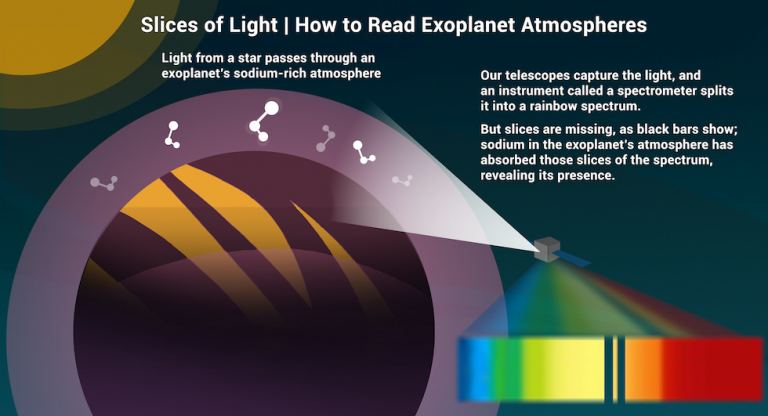Hubble Observes Exoplanet Atmosphere Shifts Across a Three-Year Span
To gain deeper insights into an exoplanet’s atmosphere, observing its dynamic changes over time is key—a principle upheld by a team of astronomers who recently disclosed findings about conditions on Tylos, also recognized as WASP-121 b.
Tylos, a scorching Jupiter-like world, orbits WASP-121 in a tidally locked pattern, completing an orbit in just 30 hours, always presenting the same face to its star. Consequently, one hemisphere endures extreme heating, surpassing temperatures of 3000 K. This intense heat profoundly influences Tylos’s weather, generating a prominent hotspot on the side facing the star, resulting in an intriguing array of chemicals within its high-temperature atmosphere.
Principal investigator Quentin Changeat highlighted the astronomers’ goal to monitor the heat-induced alterations in the atmosphere. Their study, leveraging three years’ worth of Hubble data, aimed to comprehend the atmospheric dynamics of Tylos. Changeat emphasized the significance of studying exoplanetary weather in unraveling the complexities of their atmospheres, especially in the pursuit of identifying exoplanets with potentially habitable conditions. Drawing parallels to Earth’s weather, he underscored how terrestrial weather profoundly influences various aspects of life and how the stability of Earth’s climate and weather patterns likely played a pivotal role in enabling the emergence of life.
Hubble’s Exoplanet Atmosphere Advantage
The esteemed Hubble Space Telescope continues to compile a notably impressive collection of exoplanetary observations, offering glimpses into their atmospheres. This extensive archive allows astronomers to monitor the evolution of these worlds and their atmospheric shifts over time. Hubble’s multiple observations of Tylos have provided a unique opportunity to scrutinize the behavior of its atmosphere.
Changeat’s team amalgamated four sets of archival observations of Tylos captured using Hubble’s Wide Field Camera 3 (WFC 3). This combined dataset encompasses various perspectives: observing the planet’s transit in front of its star in June 2016, followed by its transit behind the star in November 2016. Additionally, two phase curves, measuring the light emitted by both the planet and its star during an orbit, were obtained in March 2018 and February 2019. The team meticulously processed this data, a task that demanded substantial time and effort.
“Our dataset represents a considerable investment in observing time for a singular planet and currently stands as the sole consistent compilation of such repeated observations,” elucidated Changeat. “From these observations, we extracted information crucial for characterizing the atmosphere of WASP-121 b, enabling us to infer its chemistry, temperature, and cloud formations at distinct periods. This comprehensive dataset has granted us an intricate and evolving portrait of the planet.”
About Tylos’s Atmosphere
While analyzing the datasets, the team uncovered a shifting hotspot on the planet along with alterations in the spectral composition of chemicals within the planetary atmosphere. This discovery prompted the team to develop computer models aiming to elucidate these observed shifts. The prevailing explanation suggests the presence of quasi-periodic weather phenomena at Tylos, resembling substantial cyclonic formations. These phenomena appear, surge across the upper atmosphere, and eventually diminish over time. The significant temperature differentials between the warmer and cooler zones likely contribute significantly to the emergence of these distinct patterns.
Moreover, the behavior of the hotspot on Tylos presents a particularly intriguing aspect. While hotspots are relatively common, they exhibit a tendency to not remain stationary but rather undergo slight migrations within the atmosphere. This “offset” position has been observed in numerous exoplanets, suggesting a potential link to upper atmospheric winds or other disturbances that impact hotspot stability.
Observing shifts in a hotspot and alterations in weather patterns on a celestial body situated 880 light-years away signifies a significant achievement, signifying substantial progress in exoplanetary observations. “The high resolution of our simulations for exoplanet atmospheres enables us to precisely model weather conditions on ultra-hot planets like WASP-121 b,” clarified Jack Skinner, a postdoctoral fellow at the California Institute of Technology and a co-leader of the project. “This marks a substantial advancement as we merge observational constraints with atmosphere simulations to grasp the evolving weather dynamics on these planetary bodies.”
Future Work
Studying exoplanets and their atmospheres isn’t a single-event endeavor. Starlight traverses the atmosphere, and during this passage, certain chemicals within the atmosphere absorb specific wavelengths of light. Analyzing the spectrum of this light reveals distinct “dropouts” corresponding to these absorptions, providing scientists with insights into the present chemical composition. Additionally, these dropouts can signal alterations in the atmospheric chemistry occurring over time.

This study highlights the significance of “temporal resolution,” emphasizing the importance of numerous observations conducted over extended periods. These additional data sets enhance models aimed at elucidating the evolution of atmospheres. A comparable approach has proven valuable in the examination of our gas giants, such as Neptune and Uranus, where initial snapshots captured tantalizing storms by the Voyager 2 spacecraft decades ago. Subsequent observations over prolonged durations, facilitated by instruments like Hubble and the Keck II telescopes, have empowered planetary scientists to monitor storms and other atmospheric disturbances. This method similarly applies to investigations of Mars and its surface features, underscoring the value of temporal resolution in these studies.
Implementing this approach in studying distant exoplanets promises to yield insights into the transformations occurring within their atmospheres. Eventually, it may provide indications regarding which exoplanets could potentially harbor life, deduced from specific chemical compositions within their atmospheric layers. Long-term observations facilitated by instruments like Hubble and, notably, the JWST, will furnish substantial evidence concerning weather patterns on remote worlds. Ultimately, these observations could unveil habitable worlds, while detailed atmospheric studies might reveal characteristics of potential life forms, their longevity, and their impact on their respective environments.
This article is republished from UniverseToday under a Creative Commons license. Read the original article.
Do not forget to share your opinion with us to provide you with the best posts !





0 Comments